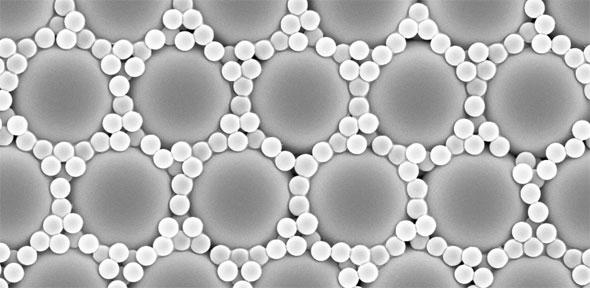
“Currently, solar panels are usually built from some form of crystalline silicon, and achieve reasonable power conversion efficiencies. However, this crystalline silicon is relatively expensive to make and is rigid and heavy, reducing the portability of the solar cells. Alternative materials could counter these problems, but for the moment cannot achieve the same efficiency as silicon.
By controlling the nanoscale structure of solar cells made from these alternative materials, it is hoped that their efficiencies can be improved. The specific nanoscale structure shown in the video is a synthetic opal, a periodic pattern of closely packed spheres, the smallest of which are only 500 nm wide. By carefully controlling the drying of these spheres from water, they can be driven to self-assemble into this opal pattern. The resultant opal can then be used as a template for fabricating nanostructured solar cells.”
The polystyrene spheres shown in the image have two diameter sizes, the larger spheres are 3 μm across and the smaller spheres are 500 nm across. The image was taken using a scanning electron microscope at the Nanoscience Centre, University of Cambridge, with thanks to Professor Ullrich Steiner, the NanoDTC and EPSRC grant EP/G037221/1.
'Nanomaterials Up Close' is a special series linked to our 'Under the Microscope' collection of videos produced by Cambridge University that show glimpses of the natural and man-made world in stunning close-up.
In this video we see a synthetic opal, which is made using polystyrene spheres surrounded by even tinier polystyrene spheres around 1,000 times smaller than the width of a human hair. Harry Beeson, from the University of Cambridge, explains how it’s important to look at nanoscale structures like this to improve the efficiency of solar cells.
The text in this work is licensed under a Creative Commons Licence. If you use this content on your site please link back to this page. For image rights, please see the credits associated with each individual image.
